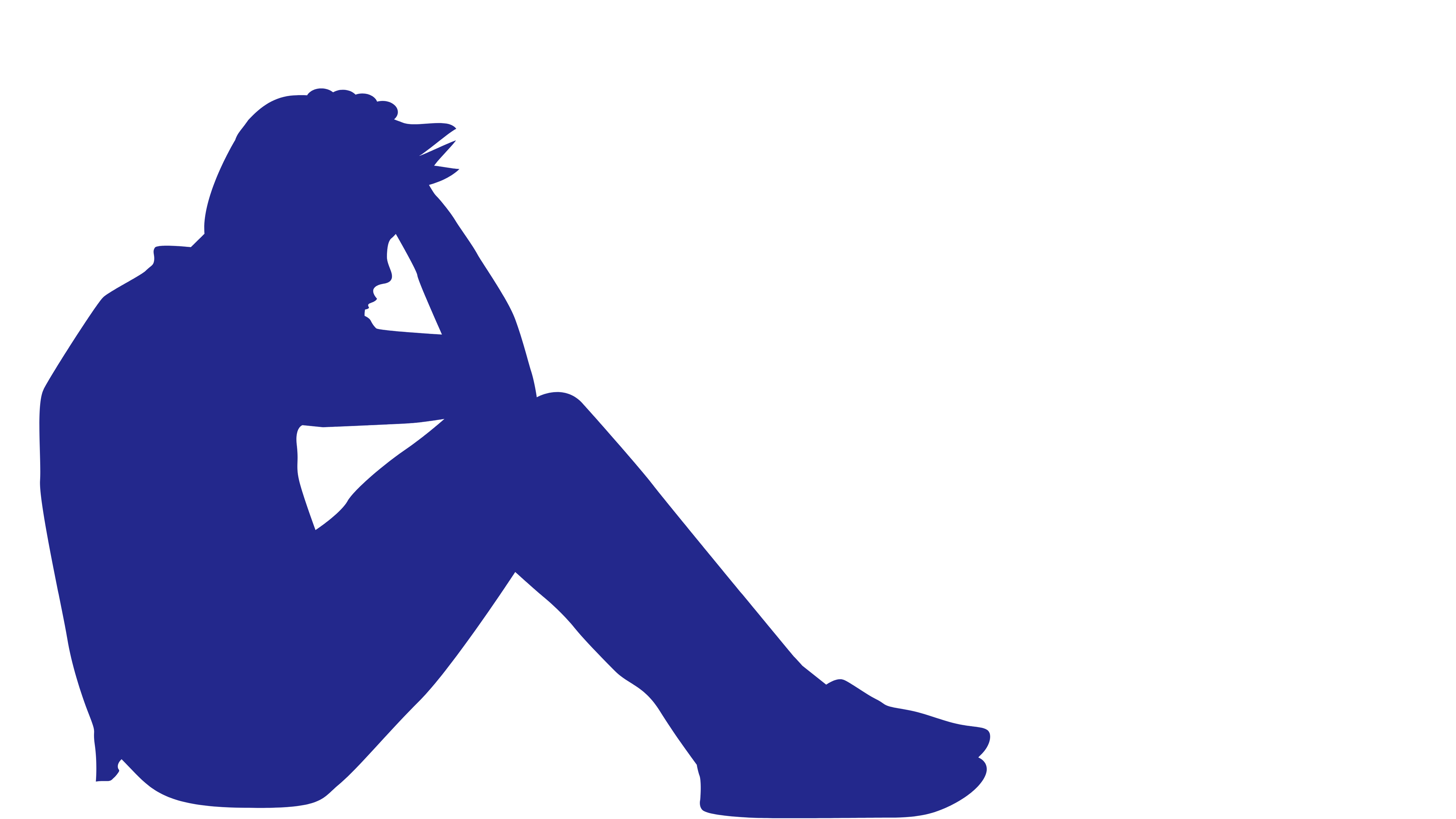Will I get through this…?
When your livelihood deteriorates, your mind starts to wander.
Imagine this: You wake up in the morning, but you feel a pit in your stomach, and it’s more than hunger – it’s stress. You wonder if you can afford lunch on campus today. Your bank account is empty, you have already used your student loan, and you won’t get more student financial aid until next week. Suddenly, you receive an email notification of an upcoming examination, and a group work requires more editing. You have two other new messages in your mailbox, and you can guess their contents from the subject line alone: “Unfortunately, we have to inform you that this time we are unable to offer you a position in our organisation.” There is only one thing on your mind: Will I survive this?
Thousands of higher education students in Finland experience this every day. It is not an exception, but a description of how many students spend their years of study.
What is going on?
“Will I get through this…?” is a campaign by the National Union of University Students in Finland (SYL) that draws attention to the link between the poor livelihood of higher education students and mental health. The campaign has been inspired by several measures taken in this government term, such as the transfer of students from general housing allowance to student housing supplement. The cuts have specifically targeted students and significantly deteriorated their already poor income, which has a proven impact on wellbeing and mental health.
We are not the only ones who have noticed the challenges students face and how they have been accumulating in recent years. In spring 2024, Akava and Akava Students conducted a campaign called My Mental Health #ImportantPartOfMe together with their member organisations. In the campaign, nearly eight hundred students and recent graduates shared their personal experiences related to mental health and coping. Most of these stories were very sad. Based on the campaign, they prepared the Valmiiksi säröillä publication containing solution proposals to wellbeing challenges that higher education students face.
The purpose of the “Will I get through this…?” campaign is to provide information and solution proposals alongside students’ experiences and as their foundation. The goal is for decision-makers and the societal debate to understand that this issue affects a large group of students. It is not just that individual students are having difficulties, this is a wider social phenomenon.
You are holding a report based on research data and the results of extensive student surveys that examines students’ everyday life and the difficulties they face. Based on the report, we now present concrete policy recommendations for ensuring students’ livelihoods and mental wellbeing in a sustainable manner in the future. The aim is to inspire us all to have a wider societal debate so that no one has to get through it alone.
We also want to extend our warmest thanks to our partners who supported us in conducting the campaign and creating the report. Specialist assistance, comments and source data have been provided by the student mental health organisation Nyyti ry and the advocacy organisation for recent graduates Akava Students.
—
Mirka Nieminen, Member of the Board
Maria Saita, Member of the Board
How does the world look like through a student’s eyes?
According to the results of the 2024 Finnish Student Health and Wellbeing Survey (KOTT), the poorer experience of livelihood students have, the more stressed they are. Up to 49% of students who feel that their livelihood is poor experience significant psychological strain (according to the MHI-5 indicator). Based on this, a link can be established between livelihood and mental health.
“The worst of all is the constant uncertainty. I don’t know if I will have enough money next month or if I dare to draw more loan. Every day, I wonder how this will affect my future.” – student, age 25
This quote is from a background discussions with students conducted in the project and summarises the situation of many students. As their livelihood is increasingly based on loan, everyday life becomes a constant balancing act: rent, food and bills must be paid, but the growing amount of loan and uncertain future take their toll. For many students, a loan is not just a temporary subsidy, but a debt that will determine their financial status up to decades after graduation.
Students’ livelihoods have deteriorated permanently, and the associated uncertainty has increased as a result of crises, cuts to social security and the rise of costs. Many do not have enough money for food, medicines or taking care of their health. This is no longer temporary. It has become a structural problem that affects the wellbeing of students and young people, the number of higher education graduates and strengthening Finland’s expert base.
Mental health symptoms have become increasingly common after the coronavirus pandemic – an alarming number of students experience exhaustion, anxiety and depression symptoms (KOTT 2024). Long sick leaves and reducing study ability affect an increasing number of students. According to a recent study by Kela, long sick leaves due to mental health issues have become more common among adult students than in any group of employed persons in 2010–2023 (Perhoniemi & Blomgren 2025).
These issues no longer concern only students themselves. This is a social cry for help that must be addressed.
Background to the phenomenon
The student benefit system becomes stricter
In the parliamentary term 2023–2027, the student benefit system is undergoing the greatest changes in its history since the early 1990s. The purchasing power of full-time students’ monetary benefits is about to decline by almost one third. The cuts have been compensated for by increasing the state guarantee for student loans by 200 euros, which has significantly increased the share of loan in student financial aid.
Over the last few decades, student financial aid and different forms of student housing support have been key equality components in Finnish education policy. The changes that are now taking place undermine this foundation, as the overwhelmingly largest cuts are targeted at students who earn poor or non-existent wages, whereas students receiving moderate monthly income of over 1,200 euros will in some cases earn up to 200–300 euros more per month. The division of students into those who fare well and those who do not will become more pronounced, and this will also be reflected in students’ wellbeing and the amount of student debt they have after graduation.
Increasingly heavy debt burden
The financial situation of higher education students has become significantly more difficult in recent years. According to the 2024 KOTT study, up to one fifth of students feel that their livelihood is poor or very poor. This means that many have to compromise on their basic needs or draw loan to manage everyday expenses.
It is increasingly common that students supplement their poor livelihood by taking a loan. According to the statistics of the Social Insurance Institution of Finland (Kela), a student graduating with a master’s degree in 2024 had an average of 24,714 euros of student debt (Kela, unpublished source), whereas the amount of debt in 2014 was only 7,303 euros (Kelan opintoetuustilasto 2014, available in Finnish and Swedish). The loan amounts of recent graduates have more than tripled over ten years (Kelan opintoetuustilasto 2023). The development over the recent years and the cuts to students’ livelihoods planned in this parliamentary term are likely to further increase debts, and the limit of 30,000 euros may be surpassed in this parliamentary term or at the latest before 2030.
Suggested reasons for the increased loan amounts include the poorer purchasing power of monetary benefits and increasing the share of loan, low interest rates and the introduction of student loan compensation. However, according to the Eurostudent VII study, the main underlying reason seems to be students’ insufficient livelihood, as 69% of higher education students reported drawing a student loan due to an insufficient benefit level (Lauronen 2025; referring to Korkeamäki & Vuorento 2021).
The Guarantee Foundation, which provides debt counselling and arrangements, has determined that student loans are an increasingly more common factor in young adults’ debt problems. The fact that the system is largely dependent on loan and the resulting increase in student loans are also reflected in expenses related to guarantee liability and assistance with student loan interest that fall under Kela’s responsibility. In 2024, Kela paid 112 million euros in student loans to banks as a guarantor. The debtors of these loans had neglected to pay interest or repay instalments, and the amount of these loans has increased almost fivefold from 2020 (Kela, unpublished source).
When students have to finance their life with debt and see the amount of debt first reach 10,000 euros, then 20,000 euros and more often even 30,000 euros in the course of their studies, few people can avoid feeling under pressure.
Impacts of livelihood on students’ everyday life
Around one in four students reported that they have feared that they would run out of food due to a lack of money, and nearly one in five reported having had to compromise on buying medicines due to a lack of money over the past 12 months, according to the KOTT 2024 study. These shares have increased significantly compared to the results of the 2021 KOTT study.
According to the Eurostudent VIII survey conducted in 2022, 45% of students experienced some difficulties with livelihood. Foreign students (60%), students with partial study ability (58%) and students transferring directly from work to studies (52%) experienced difficulties with livelihood most often. (Ministry of Education and Culture 2023.)
In the Eurostudent VIII study, students who have reported that they suffer from a diagnosed health problem that, in the student’s experience, hampers their studies are defined to have partial study ability. The number of students with partial study ability in Finland has increased from 22% reported in the Eurostudent VII survey in 2019 to over 30% of students in three years. The increase in the number of students with partial study ability has also been observed when comparing the results of KOTT studies for different years. (Saari, J., Koivuranta, S. & Nevalainen, E. 2023.)
The link between livelihood and mental wellbeing
Uncertain and poor livelihood deteriorates students’ wellbeing, mental health and study ability. The results of the KOTT 2024 study show that the prevalence of psychological strain among students increases the poorer they feel their livelihood is, regardless of age and gender.
Similar results have also been found in other studies. According to the 2019 Student Barometer, the mental wellbeing of students with poor and uncertain livelihood was approximately twice as likely to be poor compared to others (Student Barometer 2019). According to a master’s thesis (Kotilainen & Remes 2024) based on the KOTT 2021 study, the financial concerns of higher education students are also linked to depression and difficulties with concentration (Lauronen 2025).
According to the KOTT 2024 study, 29% of students experienced significant psychological strain. Although the phenomenon had become less prevalent since 2021, it is still more common compared to the rest of the population (KOTT 2024). Students are in a worrying situation, as they are future experts about to enter the workforce, whose wellbeing and especially their coping are important for the functioning of our society as a whole.
According to a recent study by Kela, the number of students’ long mental health-based sick leaves has increased between 2010 and 2023 more than in any group of employed persons. Sick leaves for depression have increased most, especially among women. (Perhoniemi & Blomgren 2025.)
In the majority of studies examining the links between income level and depression, a link between low income and depression symptoms has been observed in high, medium and low-income countries and among groups of adults of all ages (Lauronen 2025; referring to Lund & Cois 2018; Sareen et al. 2011; Osafo et al. 2015). The connection between income and depression was significantly stronger in the lowest income classes (Lauronen 2025; referring to Zimmermann & Katon 2005). The strongest connection between income level and depression has been observed among those with the worst financial situation. The report acknowledges that higher education students are a very heterogeneous group, but there are many vulnerable people among them.
In connection with students’ poor livelihood, the societal pressure for students to finance their lives with debt must also be considered. Indeed, student debt and indebtedness are associated with many impacts that must be taken into consideration when examining the connection between livelihood and mental health.
The focus of this report is on the impacts of livelihood on mental health, but we are aware that mental health also affects livelihood, and various indirect factors are linked to the phenomenon (Lauronen 2025).
Studies have found that student debt is linked to stress, anxiety and depression and, more generally, to individual mental health and wellbeing (Lauronen 2025; referring to Sinha et al. 2024). According to Sinha et al. (2024), student debt burdens vulnerable groups in particular (Lauronen 2025). Many studies on this link have been conducted in countries where student loans are fairly large, and the difference between international systems affecting interpretation have been taken into consideration in the report. In Finland, the amount of debt incurred by students has remained moderate until the recent years, but as loan amounts increase rapidly, it is very possible that this will cause an even heavier strain on mental wellbeing.
To summarise, clear evidence has been found in both domestic and international research on the connection between the livelihoods of higher education students and the perceived stress, mental wellbeing and progress of studies.
One clear result based on research literature is that the link between income and mental health is the strongest among the most disadvantaged; students with a disability were emphasises in domestic literature, and members of different minority groups were emphasised in international literature.
The identified key issues include the risk of (over)indebtedness in relation to future ability to repay, the accumulation of problems and the special vulnerability of the most disadvantaged in terms of poor livelihood.
Policy recommendations
1. Students’ livelihood
- All monetary student benefits, such as student grant, housing supplement, raise in student grant for students with children, the amount of student loan and meal subsidy, are tied to a relevant index. In 2024–2027, no index increases will be made to the study grant and the raise in student grant for students with children. No index has been set for the housing supplement at all. The existence of an index link ensures that the increase in the costs of living is taken into consideration in student benefits. Students already have a low income level, and the lack of an index link increases the risk of excessive indebtedness.
- Increase students’ monetary benefits to the level of basic security. The total amount of student benefits, i.e., the amount of study grant, housing supplement and student loan compensation, should be at a level that allows full-time studies. Students are the only population group that is expected to live on a loan. This deteriorates students’ status and increases inequality, especially in situations where indebtedness involves risks or it is uncertain whether they can repay the loan.
- Remove the requirement of 20 credits necessary to continue receiving student financial aid after studies have been interrupted to better take students’ individual life situations and wellbeing during their studies into consideration. The current requirement does not take into consideration life situations, such as mental health challenges or illnesses. Incentives and flexibility should be created to encourage continuing studies.
- Increase the number of degree-specific months of student financial aid by 9. This would allow students to progress in their studies in the summer and be more flexible.
- Give international students the right to a benefit that secures livelihood and the state guarantee for student loans. International students are often completely dependent on their own or their family’s money, which is a major financial barrier to studying in Finland. The right to income security and a state-guaranteed student loan would promote the accessibility and international attractiveness of education and integration into Finnish society. Relying on benefits that secure livelihood must not be grounds for refusing a residence permit for studies.
2. Student loan security and financial advice
- Increase the student loan compensation by an amount corresponding to the increase in student loans. The amount of student loan compensation has remained unchanged since 2017. An increase would ensure that the relative value of the loan compensation is maintained and alleviate the financial uncertainty caused by drawing a loan.
- Investigate the introduction of an annual student loan compensation that encourages completing studies within the target time. The current student loan compensation is paid only after graduation, which does not support the student’s finances during their studies. Annual compensation would improve the incentive to complete studies within the target time, reduce the loan burden at the time of graduation, and this model would help students cope.
- Increase the income limits for student loan interest assistance and extend its duration. Assistance with student loan interest is the last-resort security to cover interest expenditure, but its income and duration limits exclude many low-income graduates. The increasing student loan interest rates increase the payment burden especially after graduation, when the graduate’s income is often poor and uncertain.
- Relax the conditions for cancelling loans transferred to and recoverable by Kela in situations where the debtor’s status is poor. A more moderate system would support those with permanently poor ability to pay, for example due to a chronic disease, unemployment or other similar reason. This would reduce social inequalities and prevent over-indebtedness, which may lead to social exclusion and long-term social costs.
- Integrate financial and debt counselling in student services. Student loan burden has been increasing, which also poses new challenges to financial management both during and after studies. Regular low-threshold debt counselling clinics should be made available on higher education campuses in cooperation with the National Legal Services Authority, the Guarantee Foundation and other financial advisors.
- Recommendations for banks on responsible marketing of student loans. Students are the only population group expected to finance their everyday life by drawing a loan during their studies. This makes them very vulnerable, which must also be taken into consideration in the marketing of loans. For this reason, common policies should be created on how student loans are presented to young clients – the risks and impacts related to drawing a debt should be discussed more extensively, especially with those in a financially vulnerable position.
- Tailored financial guidance for students with difficulties and students who are concerned about their financial situation, referring them to social services if necessary (e.g., social assistance, housing-related allowances during life-changing events, such as having children).
3. Affordable housing
- Improve cooperation between higher education institutions and housing consultation services so that students are referred to housing consultation services early enough, especially in rental debt situations, to avoid evictions and payment default entries.
- Investment grants for special groups in student housing construction must be reinstated. This would enable new construction and renovation without significant rent increases.
- Take the adequacy of affordable student housing and the versatile supply of housing into consideration in city planning policies. The high price of housing in cities is one of the most significant causes of issues with students’ livelihood. Versatile offerings (small apartments, family apartments, communal housing) meet the needs of different students.
- Reform the resident selection criteria for student housing. Priority should be given to those with a special need for support (e.g., low-income students, students with families, international students).
- In resident selection, flexible practices are created that take into consideration different life situations, such as withdrawing from studies or student exchange.
4. Prevention and early support
- Make wellbeing skills a more integral part of orientation to studies. At the beginning of their studies, students are provided with information on generic and metacognitive skills, financial management for students, emotional skills, developing mental health literacy and the available support services offered by higher education institutions and the Finnish Student Health Service (FSHS).
- Set binding dimensions for psychologist and school social worker services in higher education institutions. This would improve and support the wellbeing and support needs of higher education students and increase equality.
- Introduce wellbeing mentors. Together with student actors, the FSHS and higher education institutions could train tutors and study and career advisers to identify stress factors visible in students’ everyday life and to refer students to support services as early as possible.
- Bring service centres to higher education campuses. Bringing pop-up-style shared service points for the FSHS, higher education institutions’ study services, Kela and other actors providing support to students (such as social welfare services) to higher education campuses. This would enable referring students to services and low-threshold counselling without long wait times.
- Tools for health working groups for creating a healthy everyday life for students. Health and wellbeing working groups operating in higher education institutions and coordinated by the FSHS should be supported more comprehensively so that they could, for example, actively organise more higher education institution-specific wellbeing events on campuses. Engaging with students is important in encountering them.
- Improve cooperation related to student support. The prerequisites for cooperation between organisations and other actors providing support and their consideration in resourcing should be strengthened. Coordinating extensive cooperation requires the ability to manage a broad range of services offered to students for diverse challenges with study ability.
- The needs of students with partial study ability must be taken into consideration more comprehensively in the arrangements and completion methods of studies. According to the recent KOTT study (2024), nearly one third of higher education students have a disability that makes it more difficult for them to cope with their everyday life and studies. For example, neurodiversity should be considered more comprehensively in support and guidance services.
- More surveys during studies. The preventive and risk-oriented HealthStart questionnaire should also be extended to first-year students completing their second degree and those at the end of their studies.
- Increase awareness of sickness allowance and rehabilitation services among students. According to Kela, sickness allowance is an underused benefit among students. Kela estimates that students do not necessarily feel or know that they are entitled to this allowance.
5. Developing student health care and FSHS services
- Extend FSHS services to all higher education students. International students, whether from EU and EEA countries or from outside these countries, both degree and exchange students, should be covered by FSHS services.
- FSHS’s health and wellbeing surveys at the beginning of studies (e.g., HealthStart) must also be extended to transition phases, such as returning from sick leave. This would allow identifying risks early and referring the student to the correct services as early as possible so that the issues do not recur and/or accumulate.
- Expand and develop student health meetings (OTE) especially for those with long-term strain or at risk of withdrawing from studies. “Lighter” forms of support must also be offered, such as pre-filled digital forms for expressing worries that are used to assess the situation. Service paths that facilitate returning to studies discussed with a FSHS health care specialist should also be developed.
- Diversify online services: The FSHS’s digital services (self-care paths, chat functions and group activities) must be easily accessible and more widely known. For example, a daily survey indicator asking “How are you feeling today?” could be integrated on the digital platform, and the responses would provide information on students’ experienced wellbeing over a longer time period.
- Extend the therapy guarantee to all students under the age of 30 and higher education students. It has been noted that stress during higher education studies and thus the need for mental health support is most prominent at the beginning and at the end of studies. The current age limit for the therapy guarantee (under the age of 23) excludes the majority of higher education students. Extending the therapy guarantee would also support a smoother transition from studies to employment.
Implementing these recommendations requires extensive cooperation across sectoral and actor boundaries – between higher education institutions, municipalities, the FSHS, wellbeing services counties, Kela, student housing communities and organisations.
We also feel that students’ wellbeing requires strong and unambiguous national guidance that supports the implementation of equal services in all municipalities with higher education institutions. This would allow every higher education student to benefit from them.
Sources
Suomen virallinen tilasto; Kelan opintoetuustilasto 2013/14. From: https://helda.helsinki.fi/collections/486d97ed-5d64-4212-9853-a965dd2d26cc (in Finnish)
Suomen virallinen tilasto; Kelan opintoetuustilasto 2023/24. From: https://helda.helsinki.fi/collections/486d97ed-5d64-4212-9853-a965dd2d26cc (in Finnish)
Lauronen, T. (2025). Korkeakouluopiskelijoiden toimeentulon ja mielenterveyden väliset yhteydet. Kirjallisuuskatsaus. Opiskelun ja koulutuksen tutkimussäätiö Sr (Otus).
Ministry of Education and Culture. (2023). EUROSTUDENT VIII Survey: Higher education students consider their digital skills to be good enough. Press release. At: https://valtioneuvosto.fi/-/1410845/eurostudent-viii-kysely-korkeakouluopiskelijat-kokevat-digiosaamisensa-riittavan-hyvaksi?languageId=en_US
Opiskelijabarometri (2019). Korkeakouluopiskelijoiden mielen hyvinvointi. Analysis package. Opiskelun ja koulutuksen tutkimussäätiö Sr (Otus). At: https://www.otus.fi/wp/wp-content/uploads/2020/05/Korkeakouluopiskelijoiden-mielen-hyvinvointi1.pdf (in Finnish)
Perhoniemi, R. & Blomgren, J. (2025). Long-term sickness absences based on mental disorders by socioeconomic group – trends of prevalence in Finland 2010–2023. BMC Public Health 25, 1277 (2025). At: https://doi.org/10.1186/s12889-025-22431-x
Saari, J., Koivuranta, S. & Nevalainen, E. (2023). Eurostudent VIII – Student Survey 2022. Publications of the Ministry of Education and Culture: 2023:34. At: Eurostudent VIII – Student Survey 2022
Finnish Institute for Health and Welfare. (2024). The Finnish Student Health and Wellbeing Survey (KOTT). At: https://thl.fi/en/research-and-development/research-and-projects/the-finnish-student-health-and-wellbeing-survey-kott-




